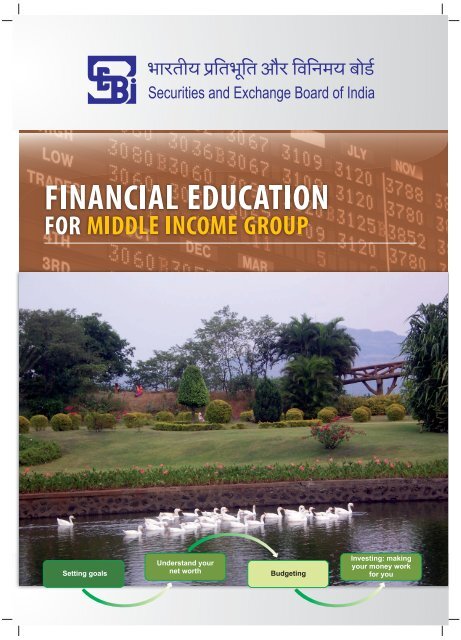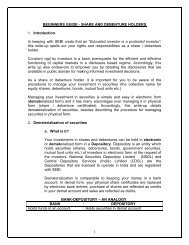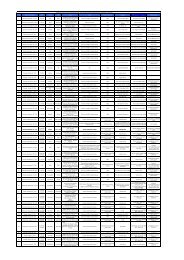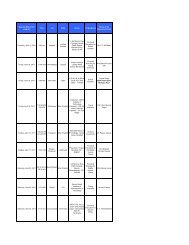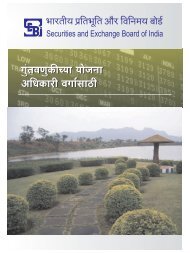Booklet - SEBI Investor Awareness Website - Securities and ...
Booklet - SEBI Investor Awareness Website - Securities and ...
Booklet - SEBI Investor Awareness Website - Securities and ...
You also want an ePaper? Increase the reach of your titles
YUMPU automatically turns print PDFs into web optimized ePapers that Google loves.
TABLE OFCONTENTS1. Introduction2. Basics of Savings & InvestmentsSetting GoalsRetirement planningBudgetingEffects of Inflation on InvestmentsRisk <strong>and</strong> ReturnPower of Compounding & Time Value of Money3. Choosing the Right Investment Options4. Asset Allocation Strategy5. Self Portrait6. Savings & Investment Related ProductsBanksGovernment SchemesBondsDebenturesCompany Fixed DepositsMutual FundsEquity SharesFinancial Planning PyramidsPonzi schemeInvestment Philosophies7. Protection Related ProductsInsurance PoliciesHealth Insurance8. Borrowing Related ProductsPersonal LoansHome LoansReverse MortgageLoans Against <strong>Securities</strong>Credit Card DebtSteps to Avoid Excess Debt9. Advantages of Financial Education10. <strong>Investor</strong> Protection & Grievances Redressal Mechanism3
1. INTRODUCTIONFinancial planning is a must for every household. Financial planning goes beyondsavings. It is an investment with a purpose. It is a plan to save <strong>and</strong> spend futureincome. It should be carefully budgeted. Financial Planning is the process of meetingyour life goals through proper management of your fi nances. Life goals can includebuying a house, saving for your child’s higher education or planning for retirement.Today you fi nd people living beyond their means, having credit card debt, makingrisky investments <strong>and</strong> doing things that are irresponsible <strong>and</strong> against the basicprinciples of fi nancial planning. Further the proliferation of new <strong>and</strong> often complexfi nancial products dem<strong>and</strong>s more fi nancial expertise. Also turbulent conditions <strong>and</strong>changing tax laws compound the need for adequate fi nancial planning. Thus it hasbecome inevitable for all to get into fi nancial planning <strong>and</strong> underst<strong>and</strong>ing fi nancialproducts.Financial planning envisages both short term <strong>and</strong> long term savings. A portion of thesavings is invested in certain assets. There are various investment options in theform of assets: bank deposits, government saving schemes, shares, mutual funds,insurance, commodities, bonds, debentures, company fi xed deposits etc.Financial planning isn’t something that happens by itself. It requires focus <strong>and</strong>discipline. It is a six step process that helps you take a ‘big picture’ look at where youare <strong>and</strong> where you want to be fi nancially4
2. BASICS OF SAVINGS AND INVESTMENTYour Parents were right: money doesn’t grow on trees. It actually grows on othermoney – which is where we get the old saying, “It takes money to make money”?Money does have an amazing ability to make more money. The good news is itdoesn’t take much money to make this happen.Savings <strong>and</strong> InvestingSaving is what people usually do to meet short term goals. Your money is very safe ina savings account <strong>and</strong> it is usually earning a small amount of interest. It’s also easyfor you to get to your money when you need.Investing means you’re setting your money aside for long – term goals. There’s noguarantee that the money you invest will grow. In fact, it is normal for investments torise <strong>and</strong> fall in value over time. But in the long run, investments can earn a lot morethan you can usually make in a savings account.Why are savings <strong>and</strong> investing so important to your financial goal?For one, saving or investing money for your fi nancial goals makes you less temptedto spend it. But the best reason for investing is that your money is actually makingmoney for you. Any interest or investment gains get you that much closer to yourfi nancial goals. And you didn’t have to do anything for it!Start saving early <strong>and</strong> you’ll be prepared when you need it, whether you’re savingfor a home, a child’s education, or your retirement. If you start saving in your 20s,you’ll be off to a great start. If you don’t, you’ll play catch-up for the rest of yourlife. Youngsters have an advantage that older people don’t have: time. When theyunderst<strong>and</strong> this concept <strong>and</strong> use time in their favour, young people have a muchbetter chance of pursuing their dreams <strong>and</strong> reaching their fi nancial goals.The Price of ProcrastinationYou know that the more time you have to invest, the more money you are likelyto end up having. But the fl ip side of that is true too. By waiting to invest, you’repaying an opportunity cost. It’s easy to say that you don’t have enough money to startsaving <strong>and</strong> investing now – “I’d rather wait until I have more money.” But that decisionprobably costs you more than you think because the power of compounding worksboth ways. It costs you because waiting means giving up earning compound interestfrom even just a small amount of money.Ask yourself the following question:-Could you spend 10 percent less than you do now, still have fun <strong>and</strong> put that moneyto work for your future? If you could save 10 percent of your income for future goals,what would those goals be? It takes more than luck to get what you want out of life.People need to know that by “paying yourself fi rst” – making saving a priority – theycan do more than just dream about what they want in the future.Whether one’s income is small or large, setting aside some of it for investmentsrequires self-discipline. By maintaining discipline to postpone buying certain thingsthey’d like to have now they can enjoy the longer term benefi ts of having that moneywork for them through savings <strong>and</strong> investments.5
Path to achieve Financial Freedom:Setting GoalsList the fi ve goals you have in life:1.2.3.4.5.Goals can be defi ned as things we want to achieve in life, towards which we directour efforts. Let us assume that you have a goal of running a marathon. You don’t wantto start of <strong>and</strong> run at full speed right at the beginning <strong>and</strong> later realise that you areunable to fi nish. Knowing that the distance to be covered is long, you can plan yourpace. Also it will help you prepare for the race by training accordingly. Goals can helpus be focused <strong>and</strong> work out a plan to achieve them.It’s rare that anyone has enough money to spend on every single want. Studies showthat even multi-millionaires believe that they need about twice what they have to feelworry-free. So everyone has to make choices <strong>and</strong> set priorities—a good fi nancial planhelps you through that process.GoalsGoals are statements about where you want to end up. They are what you want toachieve. Goals don’t talk about how you will do it. Goals focus on what you want to do.Goals should be SMARTSpecifi cMeasurableAchievableRealisticTime bound— focused, NOT general.— you can tell when you’ve reached them.— they are possible.— based on the resources.— there is a deadline.6
Goals come from your values. What you believe is important, will lead you to choosecertain goals. Finally <strong>and</strong> most importantly, write down your goals. You are morecommitted to goals when you write them down. By documenting your goals, you cansee <strong>and</strong> touch them. You can also share them with others. Keep your goals in avisible place, so you’ll see them daily. One of the important goals for an individual isplanning for his family for the risk of his demise.Retirement PlanningList down the five ways in which retirement planning was being done 30 yearsback1.2.3.4.5.What are the 5 things that you need to do for your retirement planning?1.2.3.4.5.How much you should invest to create your retirement fund?Let suppose Ram at the age of 30 with monthly expenses of ` 10,000 wants toretire at the age of 60 (Life expectancy of 75). What is the corpus he requires for hisretirement assuming that he will require 80% of his present expenses? And how muchamount he should save every month to build his retirement corpus?To fi nd the corpus <strong>and</strong> monthly investment , fi rst of all we have to fi nd that how muchhe will be spending every month at the age of his retirement, because his currentexpenses in money value are going to increase in future because of Infl ation.Step 1: Value of his expenses at the time of retirement with 5% Infl ation?No. of yearsafter which 5 10 15 20 25 30you will retireAmount forexpenses you needevery month at the(12,762.82) (16,288.95) (20,789.28) (26,532.98) (33,863.55) (43,219.42)time of RetirementAmount forexpenses you needevery month at thetime of Retirement(10,210.25) (13,031.16) (16,631.43) (21,226.38) (27,090.84) (34,575.54)(80% of therequirement)Note: Growth in current expensesafter 30 years due to inflation7
Why expenses are less at retirement? (80% in above scenario)1.2.3.Answer: Ram is retiring after 30 years from now, so his monthly expenses would be` 43, 219 <strong>and</strong> with 80% it will be ` 34,575.Step 2: How much corpus he requires at his retirement to get continuous fl ow of cashfor his monthly expense requirement?Assumption: Return on Corpus or investment is 7%.No. of Expenses Expenses Expenses Expenses Expenses Expensesyears after of of of of of ofRetirement ` 10210.25 ` 13031.16 ` 16631.43 ` 21226.38 ` 27090.84 ` 34575.545 585,130.95 746,791.84 953,116.66 1,216,445.22 1,552,526.61 1,981,461.0810 1,117,707.64 1,426,509.65 1,820,627.96 2,323,633.90 2,965,611.10 3,784,954.7715 1,602,450.28 2,045,177.75 2,610,222.66 3,331,379.05 4,251,777.66 5,426,465.4320 2,043,655.17 2,608,279.41 3,328,898.92 4,248,612.31 5,422,425.56 6,920,541.7725 2,445,232.68 3,120,805.39 3,983,026.38 5,083,463.13 6,487,930.27 8,280,425.7830 2,810,742.02 3,587,298.21 4,578,402.57 5,843,330.78 7,457,735.34 9,518,170.11Ram will retire at the age of 60 years <strong>and</strong> his life expectancy is 75 years that makeshis expenses requirement for 15 years (75 years – 60 years).From the above table we can make out that for 15 years, his required corpus is` 54,26,465.Step 3: Ram would like to open a Systematic Investment Plan (SIP) where he willinvest money every month which grows at 10% annualised over 30 years to build hisretirement corpus. How much Ram should invest every month for the corpus?Calculations:For calculation purpose we are fi nding out the corpus for ` 10 lakhs <strong>and</strong> after gettingthe corpus we will multiply it by the required amount:Interest / No.Monthly investment require to build corpus of ` 10 LacofYear 5 10 15 20 25 306% (14,321.72) (6,125.04) (3,468.51) (2,194.69) (1,471.50) (1,021.18)8% (13,621.38) (5,516.23) (2,943.09) (1,746.24) (1,093.09) (705.41)10% (12,958.11) (4,963.82) (2,489.91) (1,381.24) (804.40) (480.93)12% (12,329.91) (4,463.57) (2,101.14) (1,087.13) (587.47) (324.57)15% (11,449.24) (3,802.02) (1,622.41) (753.54) (362.77) (177.56)With the above table we can make out that he has to invest ` 480/month of ` 10lakhs. Therefore for ` 54 lakhs, he has to invest ` 2,592 every month = (54/10) x 480= ` 2,592.8
Assignment:Calculate the retirement corpus required by you <strong>and</strong> the monthly investment requiredto build that corpus based on the tables given below:1. Your monthly expenses ( )(For calculation purpose monthly expenses are given as ` 10,000. If yourexpenses are ` 20,000 then multiply the corpus by 2)2. Your monthly expenses requirement at the time of retirement with infl ation rate of5% __________No. of yearafter which 5 10 15 20 25 30you will retireAmount forexpenses you needevery month at the(12,762.82) (16,288.95) (20,789.28) (26,532.98) (33,863.55) (43,219.42)time of RetirementAmount forexpenses you needevery month at thetime of Retirement(10,210.25) (13,031.16) (16,631.43) (21,226.38) (27,090.84) (34,575.54)(80% of therequirement)3. Retirement corpus you require for getting regular cash fl ow ___________No. of Expenses Expenses Expenses Expenses Expenses Expensesyears after of of of of of ofRetirement ` 10210.25 ` 13031.16 ` 16631.43 ` 21226.38 ` 27090.84 ` 34575.545 585,130.95 746,791.84 953,116.66 1,216,445.22 1,552,526.61 1,981,461.0810 1,117,707.64 1,426,509.65 1,820,627.96 2,323,633.90 2,965,611.10 3,784,954.7715 1,602,450.28 2,045,177.75 2,610,222.66 3,331,379.05 4,251,777.66 5,426,465.4320 2,043,655.17 2,608,279.41 3,328,898.92 4,248,612.31 5,422,425.56 6,920,541.7725 2,445,232.68 3,120,805.39 3,983,026.38 5,083,463.13 6,487,930.27 8,280,425.7830 2,810,742.02 3,587,298.21 4,578,402.57 5,843,330.78 7,457,735.34 9,518,170.114. Monthly investment you require to build your corpus ___________For calculation purpose, you have to invest regularly to build the corpus of ` 10 lakhs.If your requirement is ` 20 lakhs, then multiply the monthly investment amount by 2.Interest / No.Monthly investment require to build corpus of ` 10 LacofYear 5 10 15 20 25 306% (14,321.72) (6,125.04) (3,468.51) (2,194.69) (1,471.50) (1,021.18)8% (13,621.38) (5,516.23) (2,943.09) (1,746.24) (1,093.09) (705.41)10% (12,958.11) (4,963.82) (2,489.91) (1,381.24) (804.40) (480.93)12% (12,329.91) (4,463.57) (2,101.14) (1,087.13) (587.47) (324.57)15% (11,449.24) (3,802.02) (1,622.41) (753.54) (362.77) (177.56)9
Please note that higher the return, higher is risk. It is advisable to see your risk takingability before choosing a fi nancial product.Underst<strong>and</strong> your Net worth:Please take 5 min to read the data given:The family of Mr. Dipal shah (34 years) comprises of his wife (30 years) a selfemployedprofessional, son (3 years) <strong>and</strong> mother around 65 yearsAnnual Income / Expenditure StatementItemSelf Wife Gross(`) (`) (`)Income (Salary / Professional) 2,00,000 60,000 2,60,000ExpensesHousehold Expenses 1,20,000Misc. Expenses 16,000Home loan EMI Annualised 60,000Education 12,000Personal Loan Repayment 15,000LIC Premium* (Self & Wife) 7,000Mediclaim Premium (Self & Family) 10,000Assets & Liabilities`Assets & Liabilities`Shares 40,000Life Insurance Term Plan 50,000for Self & WifeFurniture 30,000Television 10,000Home Appliances 25,000Canteen bill not paid 2,000PF (Self) 85,000Electrical Goods 3,000Company FD 25,000Residential House 6,50,000Bank FD 27,000NSC 50,000Credit card balance 25,000Phone bill not paid 2,000Bank account balance 36,000Home Loan EMI O/s 5,35,000Personal Loan 2,00,000Gold Jewelry 60,000PO MIS 1,00,000What are the assets owned by the family?1._______________________________ 6. __________________________________2._______________________________ 7. __________________________________3._______________________________ 8. __________________________________4._______________________________ 9. __________________________________5._______________________________10. __________________________________10
How will you classify the assets owned by the family?1._______________________________ 6. __________________________________2._______________________________ 7. __________________________________3._______________________________ 8. __________________________________4._______________________________ 9. __________________________________5._______________________________10. __________________________________What are the possible assets that can enhance the wealth of the family?1._______________________________ 6. __________________________________2._______________________________ 7. __________________________________3._______________________________ 8. __________________________________4._______________________________ 9. __________________________________5._______________________________10. __________________________________Learning: The focus of the family should be on accumulating assets thatwill enhance the wealth of the family.List all the liabilities for the family1._______________________________ 6. __________________________________2._______________________________ 7. __________________________________3._______________________________ 8. __________________________________4._______________________________ 9. __________________________________5._______________________________10. __________________________________Calculate the Net worth of Mr. Shah’s Family11
Learning Tracker:1. Identify all the income generating assets owned by you____________________________________________________________________________________________________________________________________________________________________________________________________________________________________________________________________________________________________________________________________________________________________________________________________________2. Identify all the liabilities you have__________________________________________________________________________________________________________________________________________________________________________________________________________________________________________________________________________________________________________________________________________3. Calculate your own Net worth as of today.BudgetingThe fi rst step in your fi nancial planning is budgeting. Budgeting is a processfor tracking, planning <strong>and</strong> controlling the infl ow <strong>and</strong> outfl ow of income. It entailsidentifying all the sources of income <strong>and</strong> taking into account all current <strong>and</strong> futureexpenses, with an aim to meet an individual’s fi nancial goals. The primary aim of abudget planner is to ensure savings after the allocation for spending.Benefits of budgeting –• It puts checks <strong>and</strong> balances in place in order to prevent overspending at variouslevels• Takes into account the unexpected need for funds• Helps discipline you• Helps one maintain his/her st<strong>and</strong>ard of living post retirementSteps for budget planning:-Step 1:- Calculate your income: This should include income from all sources, includingyour paycheck <strong>and</strong> interest from any investment12
Step 2:- Determine your expense for essentials: List out your essential expenses,which may include rent, grocery, clothing, telephone <strong>and</strong> electricity bills <strong>and</strong> fuel <strong>and</strong>vehicle maintenance. Calculate the amount spent on each.Step 3:- Note down your total debts, including interest payments on the same.Step 4:- Determine your expense for non-essentials: Your list of non essentials mayinclude vacations, gifts <strong>and</strong> trips to restaurants. Calculate the amount spent on each.Step 5:- Calculate your savings: This is done by subtracting the fi gure obtained byadding steps 2, 3 <strong>and</strong> 4 from the fi gure obtained in step 1.Realize that unexpected things come up in life. You may have to break your budgetplan, or reconstruct it, occasionally. However try to avoid debt to cover the shortage<strong>and</strong> stick to your budget as much as possible.Effects of Inflation on InvestmentsWhen you are planning your investment, it is critical that you take into account theeffects of infl ation on your investments. At its most basic level, infl ation is simply arise in prices. Over time, as the cost of goods <strong>and</strong> services increase, the value of arupee is going to go down because you won’t be able to purchase as much with thoserupees as you could have in the last month or last year.How does inflation affect my investment decision?A Vada pav which used to cost ` 2 fi ve years back now the same costs ` 7. The costincrease is not as a result of increase in quantity or better quality. The increase is aresult of increase in prices of ingredients which have increased as a result of infl ation.Change in the prices of some assets:-Assets Price in (2001- 02) Price in (2009-10)Sugar (1 kg) 16.00 40.00Cooking Oil (5 liters) 290.00 500.00Gold (10 grams) 4,474.00 17, 138Silver (1 kg) 7,868.00 28,345.00Rice (1 kg) 14.00 35.00Petrol (1 liter) 33.46 48.83Diesel (1 liter) 19.88 36.74Infl ation is greatly feared by investors because it grinds away the value of yourinvestment. Example:- If you invest ` 1,000 in a one year fi xed deposit that will return5% over that year, you will be giving up ` 1,000 right now for ` 1,050 in 1 year. If overthe course of that year there is an infl ation rate of 6%, your expenses which were `1,000 in the previous year will increase to ` 1,060 at the end of the year. Thus evenafter investing your money for 1 year you are worse off compared to the previous yearbecause the returns delivered by your investments has been below the infl ation rate.What are the steps that an investor can take to avoid the adverse effects ofinflation?Try to determine your “real rate of return” which is the return you can expect afterfactoring in the effects of infl ation. In addition to being aware of the current rate ofinfl ation, it is crucial to be aware of what infl ation rate the experts are anticipating.13
Both the value of current investments <strong>and</strong> the attractiveness of future investmentswill change depending on the outlook for infl ation. Also remember fi xed incomeinvestments are particularly vulnerable to the effects of infl ation. If you are locked intoa particular interest rate <strong>and</strong> infl ation increases, your earnings will not keep up <strong>and</strong>you will earn a negative return.Risk <strong>and</strong> ReturnRisk <strong>and</strong> investment in h<strong>and</strong>. Risk can be defi ned as the chance one takes that all orpart of the money put into an investment can be lost. The good news is that investingrisk comes with the potential for investing reward – which is what makes the wholeprocess worthwhile.The basic thing to remember about risk is that it increases as the potential returnincreases. Essentially the bigger the risk is, the bigger the potential payoff. (Don’tforget the two words -“potential payoff”. There are no guarantees)Even seemingly “no-risk” products such as savings accounts <strong>and</strong> government bondscarry the risk of earning less than the infl ation rate. If the return is less than the rateof infl ation, the investment has actually lost ground because your earning aren’t beingmaximised as they might have been with a different investment vehicle.While you stay invested it is crucial that you take necessary measures to manageyour risk. Once you invest in any asset class you should monitor your investments<strong>and</strong> keep yourself updated about various market happenings to avoid any pitfalls.Always check the potential risks when quoted returns are unusually high.Power of CompoundingAs you pursue your fi nancial planning, the most powerful tool for creating wealthsafely <strong>and</strong> surely is ‘the magical power of compounding. Albert Einstein hadonce remarked, ‘The most powerful force in the universe is compound interest’.Compounding is a simple concept that offers astounding returns: if you park yourmoney in an investment with a given return <strong>and</strong> then reinvest those earnings as youreceive them, your investment grows exponentially over time. With simple interest,you earn interest only on the principal (that is, the amount you initially invested); withcompounding, you earn interest on the principal <strong>and</strong> additionally earned interest onthe interest.Consider what the power of compounding does to an investment of ` 12,000 a year(that is, an affordable ` 1,000 a month) in a scheme that offers a 9 per cent return,over 30 years. The total investment of ` 3.6 lacs (principal) grow to ` 17.83 lacs overthat period.Compounding rewards disciplined investing <strong>and</strong> works best over long tenures. Inthe above example, the fi rst 20 years yield is just ` 6.69 lacs. The last 10 yearsshow the multiplier effect of the power of compounding. The longer you leave yourmoney untouched, the faster <strong>and</strong> bigger it grows. For instance, stretching the aboveinvestment pattern to 40 years will give you ` 44.20 lacs.Compounding, thus, is a wonder tool that lets you make the most of smallinvestments made over long periods of time to accumulate phenomenal wealth. Itworks best if you start investing early <strong>and</strong> leave the money alone. Compounding is,in fact, the single most important reason for you to start investing right now. Every14
day you are invested is a day that your money is working for you, helping to ensure afi nancially secure <strong>and</strong> stable future.Illustrations: Power of CompoundingSantosh <strong>and</strong> Sunil are friends <strong>and</strong> both want to invest ` 1 lac @ 10% pa. But Santoshwill get compounding interest rate of 10% <strong>and</strong> Sunil will get Simple interest rate of10% on their investmentsNow see the power of compounding:Year Compounding @ 10% Simple interest @ 10%1 1,10,000.00 1,10,000.002 1,21,000.00 1,20,000.003 1,33,100.00 1,30,000.004 1,46,410.00 1,40,000.005 1,61,051.00 1,50,000.0020 6,72,750.00 3,00,000.0025 10,83,470.59 3,50,000.0030 17,44,940.23 4,00,000.001. After one year both will get same amount i.e. ` 110, 0002. After 5 years Santosh will get ` 1, 61,051 <strong>and</strong> Sunil will get ` 1, 50,000.3. After 30 years Santosh will get ` 17, 44,940 <strong>and</strong> Sunil will get ` 4, 00, 000,A difference of ` 13.4 lac in 30 years1. Divya invests ` 500 today in an account earning 7% p.a interest ratecompounded annually. How much will it be worth in?a. 5 years?b. 10 years?c. 20 years?2. Now Divya finds an account that earns 10% p.a interest rate compoundedannually. How much will her ` 500 be worth at the new rate in:a. 5 years?b. 10 years?c. 20 years?The Rule of 72You now know that the concept of compounding means that your money is makingmore money even while you sleep. One way to see how powerful this can be is calledthe Rule of 72.Mathematicians say that you can see how long it will take you to double your moneysimply by dividing 72 by the interest rate. So let’s say your gr<strong>and</strong>parents give you` 200 for your birthday <strong>and</strong> you plan to invest it. If you put the money into an accountthat earns 6 percent interest a year, how long will it take to grow to ` 400?15
72 ÷ 6% interest = 12 yearsSo in 12 years, your money will have doubled to ` 400. But what if your dad tells youabout an account where you could earn 9 percent a year on your money?72 ÷ 9% interest = 8 yearsNow you will have that ` 400 in only eight years. By earning just a little bit moreinterest, you reduce the time to double your money by four years. And this doesn’tinclude any additional money that you may put into your account over time, whichwould only speed up the process.But what if eight years seems too long to wait <strong>and</strong> you want that ` 400 in four yearsinstead? The Rule of 72 can also tell you the interest rate you need to earn to doubleyour money in a certain amount of time. So for four years it would be:72 ÷ 4 years = 18% interestYou can now see how even a small difference in the interest rate you earn can makea big difference in how quickly your money compounds — earning you more money— over time.Time Value of MoneyAs time passes, you will realise that if 10 years back you could afford to purchasea full lunch for ` 10, today you might afford to get a few pieces of vegetables only.This means that the value of a thous<strong>and</strong> rupee note would be higher today than afterfi ve years. Although the note is the same, you can do much more with the money ifyou have it now because over time. The value of ` 1,000 will decrease because ofinfl ation.At the most basic level the time value of money demonstrates that time literally ismoney - the value of the money you have now is not the same as it will be in thefuture <strong>and</strong> vice versa16
3. CHOOSING RIGHT INVESTMENT OPTIONSThe choice of the best investment options will depend on personal circumstances aswell as general market conditions. An investment for one’s objective may not suit theneeds of the other. Right investment is a balance of three things: Liquidity, Safety <strong>and</strong>Return.LiquidityThis will cover the ease with which the investment can be converted to cash to meetexpenses. Some liquid investments are required to meet exigencies that arise in thenormal course or otherwise.SafetyThis is about the risk factor of the investment. The worst case is losing all theinvested money.The milder case is losing on the income or low income growth or investment growth.Infl ation is also a risk, as the purchasing value of money reduces.ReturnIncome generated by investments is another factor to consider. Safe investments offersteady but lower income <strong>and</strong> risky investments offer high returns or no returns at all.There are several short-term <strong>and</strong> long-term fi nancial investment options available,some of which are given hereafter:Thus, there is a staggering variety of investments to choose from. In the followingchapters we will focus on these <strong>and</strong> explain about them.4. ASSET ALLOCATION STRATEGYEvery Asset class has its own risk <strong>and</strong> returns. Equity Investments are considered tobe risky investments as they might lead to erosion of entire capital invested, whereasgovernment bonds are considered to be risk free as you can be confi dent that thegovernment will not default on its interest payments.This is where asset allocation plays a crucial role. Asset allocation is a technique forinvesting your money into various asset classes that would suit your income <strong>and</strong> riskappetite.Asset allocation involves tradeoffs among three important variables:• Your time frame• Your risk tolerance• Your personal circumstancesDepending on your age, lifestyle <strong>and</strong> family commitments, your fi nancial goals willvary. While allocating your funds to various assets, it is important to see that youdistribute your funds across various assets to benefi t from diversifi cation.Normally, in an age based asset allocation, the amount allocated to equities is basedon the <strong>Investor</strong>’s age. The premise of using this model is “as the investor gets older,his portfolio should be more conservative”. However, as this is just a thumb rule, aninvestor is the best judge of what suits him the most.17
5. SELF PORTRAITTo know exactly where you st<strong>and</strong> fi nancially, having fi nancial statements compiledis one of the best ways to gain this kind of insight. A key component of a fi nancialstatement is a detailed <strong>and</strong> complete accounting of assets <strong>and</strong> liabilities associatedwith the person.Identifying GoalsThe most important step in fi nancial planning is identifying <strong>and</strong> underst<strong>and</strong>ing whatyou want to accomplish. Money is merely a tool to be used to satisfy your desires. Byunderst<strong>and</strong>ing what you truly want, it is much easier to plan for how much you needto accomplish your goals.Identifying AssetsOnce your goals are identifi ed, it is time to assess what assets are available to meetthem. Assets need to be categorized according to their liquidity <strong>and</strong> stability of longterm value. The key to identifying <strong>and</strong> categorizing assets is underst<strong>and</strong>ing when <strong>and</strong>how they generate cash. Make a list of all your assets which include your house,investments in shares, mutual funds, fi xed deposits, money lying in the savings bankaccount etcIdentifying LiabilitiesIdentifying your liabilities is as important as identifying the assets available. Ideally, theassets should be more than the liabilities. Planning is required to invest in assets tomeet the liabilities <strong>and</strong> have some assets left over for earning income <strong>and</strong> investmentpurposes.Likely Future EarningsWhen estimating your future earnings you need to make certain assumptions. Someof the assumptions can be as follows:-If you are a salaried employee it is safe to assume that your salary income willincrease at a rate of 8% p.a till retirement.Rate of return on debt investments can be assumed as 7% p.a. <strong>and</strong> return on equityindex as 12% p.a.The aforesaid is only indicative returns. Actual returns may vary depending on market conditions.Likely Future ExpensesHere again you need to make assumption like:-Long term infl ation rate of 5% p.a.Household <strong>and</strong> personal living expenses (including entertainment, education, marriageetc.) expenses increase at a rate of 8% p.a (3% more than the rate of infl ation)PlanningMatching cash infl ows from assets to cash outfl ows for liabilities is the crux offi nancial planning. In fi nancial planning, goals are considered liabilities due to the factthey generally require cash outfl ows. This is a multi step approach.18
Example:-Suppose your goal is to save enough money for your child’s higher educationStep 1: Determine the no. of years till your child will require higher professionaleducationStep 2: Determine the education cost today. This calculation usually involvestaking the current price of a professional course <strong>and</strong> multiplying it against anestimated annual rate of infl ationStep 3: Suppose it costs ` 1,00, 000 today for a professional course. ` 1,00,000x 1.05^12 = ` 1,79,585 would be the cost 12 years from now, with an expected 5percent annual infl ation rateStep 4: The next step is to figure out the present value of that future cashoutflow. To do that you would take the future value of the money <strong>and</strong> divide it byyour expected rate of return.The future value of ` 1,00,000 equals ` 1,79,585 as calculated above. The presentvalue of that future value with an estimated annual return of 8 percent for 12 years is` 1,79,585 / 1.08^12, which equals ` 71,315. So you need to put ` 71,315 today intoan asset that will earn you 8 percent annually on average to be able to pay for yourchild’s education in 12 years that costs 100,000 in today’s terms.Step 5: For every cash outflow you anticipate in the future, you need tocalculate the present value of that outfl ow <strong>and</strong> fi nd an asset that can be used tocover the future cost. This process need to be repeated for all your future goals.Calculate your future expenses <strong>and</strong> start saving for it today so you are in a position tomeet all of them.19
6. SAVINGS AND INVESTMENT RELATEDPRODUCTSBanksBank deposits are safe investments as all bank deposits are insured upto a maximumof ` 100,000 under the Deposit Insurance & Credit Guarantee Scheme of India.Banks are subject to control <strong>and</strong> regulated by the Reserve Bank of India. They offervarious types of deposits, depending on the needs of the customer. Bank deposits arepreferred more for their liquidity <strong>and</strong> safety than for the returns thereon. It is possibleto get loans up to 75 - 90% of the deposit amount from banks against fi xed depositreceipts.TYPES OF DEPOSITS AND KEY FEATURESSavings Bank Account• Often the fi rst banking product people use• Low interest however, highly liquid• Suitable for inculcating the habit of saving among the customersBank Fixed Deposit (Bank FDs)• Involves placing funds with the banks for a fi xed term (not less than 30 days) for acertain stipulated amount of interest• The ideal investment time for bank FDs is 6 to 12 months as normally interest onbank for less than 6 months bank FDs is likely to be low• The time frame assumes importance as early withdrawal may carry penaltyRecurring Deposit Account• Some fi xed amount is deposited at monthly intervals for a pre-fi xed term• Earns higher interest than Savings Bank Account• Helps in the saving of a fi xed amount every monthSpecial Bank Term Deposit Scheme• This is the Tax Saving Scheme available with banks• Relief under Section 80C of the Income Tax Act available• Term deposit of fi ve years maturity in a scheduled bank is m<strong>and</strong>atoryGOVERNMENT SCHEMESTax Savings Schemes*The Government of India has launched Income Tax Saving Schemes including:• National Savings Certifi cate (NSC)• Public Provident Fund (PPF)• Post Offi ce Scheme (POS)Besides, Equity link savings scheme (ELSS) offered by Mutual Funds <strong>and</strong>20
Infrastructure Bonds of Financial Institutions / Banks also offer tax benefi t. Theincomes from the investment are exempt from Income Tax <strong>and</strong> the investments inthese schemes are deductible subject to certain limits from the taxable income.National Savings Certificates (NSC)• Popular Income Tax Savings scheme, available throughout the year• Interest rate of 8%• Minimum investment is ` 100/- <strong>and</strong> with no upper limit• Maturity period of 6 years• Transferable <strong>and</strong> a provision of loan on the basis of this schemePublic Provident Fund (PPF)• Interest rate of 8.6% p.a• Minimum investment limit is ` 500/- <strong>and</strong> maximum is ` 1,00,000/-• Maturity period of 15 years• The fi rst loan can be taken in the third fi nancial year from the date of opening ofthe account, or upto 25% of the amount at credit at the end of the fi rst fi nancialyear. Loan amount can be returned in maximum of 36 installments• A person can withdraw an amount (not more than 50% of the balance) every yearfrom the 7th year onwardsPost Office Scheme (POS)• It is one of the best Income Tax Saving Schemes• It is available throughout the year• Post Offi ce schemes depends upon the type of investment <strong>and</strong> maturity period,which can be divided into following categories:■ Monthly Deposit■ Saving Deposit■ Time Deposit■ Recurring DepositEquity Linked Savings Schemes (ELSS)• Mirror image of a diversifi ed equity fund, however, with tax benefi t U/S 80 C• Lock in period of three years• Dividends are also tax free• On sale of these units, benefi t can be obtained of long term capital gains, onwhich no capital gains tax is to be paid• Minimum investment is ` 500 <strong>and</strong> then multiples thereof• <strong>Investor</strong> can opt for systematic investment plan (SIP)Infrastructure Bonds• Lock in period of three years• Tax benefi t U/S 88 on investments upto ` 20,000• Any redemption prior to maturity nullifi es the tax exemption* <strong>Investor</strong>s are advised to see latest Income tax provisions <strong>and</strong> other provisions from relevant sources.21
BondsA Bond is a loan given by the buyer to the issuer of the instrument, in return forinterest. Bonds can be issued by companies, fi nancial institutions, or even theGovernment. The buyer receives interest income from the seller <strong>and</strong> the par value ofthe bond is receivable by the buyer on the maturity date which is specifi ed.TYPES OF BONDSTax-Saving BondsTax-Saving Bonds offer tax exemption up to a specifi ed amount of investment,depending on the scheme the Government notifi cation. Examples are:• Infrastructure Bonds under Section 88 of the Income Tax Act, 1961• NABARD/ NHAI/REC Bonds under Section 54EC of the Income Tax Act, 1961• RBI Tax Relief BondsRegular Income BondsRegular-Income Bonds provide a stable source of income at regular, pre-determinedintervals. Examples are:• Double Your Money Bond• Step-Up Interest Bond• Retirement Bond• Encash Bond• Education Bonds• Money Multiplier Bonds• Deep Discount BondsKey Features• Rated by specialised credit rating agencies like, CRISIL, ICRA, CARE, Fitch etc.The yield on a bond varies inversely with its credit (safety) rating• Suitable for regular income. Interest is received semi-annually, quarterly ormonthly depending on type of bond• Bonds available in both primary <strong>and</strong> secondary markets• Market price depends on yield at maturity, prevailing interest rates, <strong>and</strong> rating ofthe issuer• One can borrow against bonds by pledging the same with a bank• Minimum investment ranges from ` 5,000 to ` 10,000• Duration usually varies between 5 <strong>and</strong> 7 years• Can be held in demat formDebenturesKey Features of Debentures• Fixed interest debt instruments with varying period of maturity, similar to bonds,but are issued by companies• Either be placed privately or offered for subscription22
• May or may not be listed on the stock exchanges. If they are listed on the stockexchanges, they should be rated prior to the listing by any of the credit ratingagencies designated by <strong>SEBI</strong>• Maturity period normally varies from 3 to 10 yearsTypes of debentures• There are different kinds of debentures, which can be offered. They are as follows:• Non convertible debentures (NCD) – Total amount redeemed by the issuer• Partially convertible debentures (PCD) – Part is redeemed <strong>and</strong> part is converted toequity shares with or without the option to investor.• Fully convertible debentures (FCD) – Whole value is converted into equity. Theconversion price is stated when the instrument is issuedCompany Fixed DepositsKey Features• Fixed deposit scheme offered by a company. Similar to a bank deposit• Used by companies to borrow from small investors• The investment period must be selected carefully as most FDs are not encashableprior to their maturity• Not as safe as a bank deposit. Company deposits are ‘unsecured’• Offer higher returns than bank FDs, since they entail higher risks• Rating can be guide to their safetyMutual FundsA mutual fund pools money from many investors <strong>and</strong> invests the money in stocks,bonds, short-term money-market instruments, other securities or assets, or somecombination of these investments. The combined holdings the mutual fund owns areknown as its portfolio. Each unit represents an investor’s proportionate ownership ofthe fund’s holdings <strong>and</strong> the income those holdings generate.Salient Features of Mutual Funds• Professional Management – Money is invested through fund managers• Diversifi cation - Diversifi cation is an investing strategy that can be neatly summedup as “Don’t put all your eggs in one basket”. By owning shares in a mutual fundinstead of owning individual stocks or bonds, the risk is spread out• Economy of Scale - Because a mutual fund buys <strong>and</strong> sells large amounts ofsecurities at a time, its transaction costs are lower than what an individual wouldpay for securities transactions• Liquidity - Just like individual shares, mutual fund units are convertible into moneyby way of sale in the market• Simplicity - Buying a mutual fund unit is simple. Many banks have sponsored theirown line of mutual funds <strong>and</strong> the minimum investment amount is small• <strong>Investor</strong>s should examine each of the above features carefully before investing inmutual funds23
Types of Mutual FundsEach fund has predetermined investment objectives that tailor the fund’s assets,regions of investments <strong>and</strong> investment strategies. At the fundamental level, there arethree varieties of mutual funds:• Equity funds (stocks)• Fixed-income funds (bonds)• Money market fundsAll mutual funds are variations of these three asset classes. For example, while equityfunds that invest in fast-growing companies are known as growth funds, equity fundsthat invest only in companies of the same sector or region are known as specialtyfunds.Mutual Funds can also be classifi ed as open-ended or closed-end, depending on thematurity date of the fund.Open-ended Funds• An open-ended fund does not have a maturity date• <strong>Investor</strong>s can buy <strong>and</strong> sell units of an open-ended fund from / to the AssetManagement Company (AMC), at the mutual fund offi ces or their <strong>Investor</strong> ServiceCentre’s (ISCs) or through the stock exchange.• The prices at which purchase <strong>and</strong> redemption transactions take place in a mutualfund are based on the net asset value (NAV) of the fundClosed-end Funds• Closed-end funds run for a specifi c period• On the specifi ed maturity date, all units are redeemed <strong>and</strong> the scheme comes to aclose• The units shall be listed on a stock exchange to provide liquidity• <strong>Investor</strong>s buy <strong>and</strong> sell the units among themselves, at the price prevailing in thestock marketMoney Market Funds• Invest in extremely short-term fi xed income instruments• The returns may not be very high, but the principal is safe• These offer better returns than savings account but lower than fi xed depositswithout compromising liquidityBond/Income Funds• Purpose is to provide current income on a steady basis• Invests primarily in government <strong>and</strong> corporate debt• While fund holdings may appreciate in value, the primary objective of these fundsis to provide a steady cash fl ow to investorsBalanced Funds• Objective is to provide a balanced mixture of safety, income <strong>and</strong> capitalappreciation24
• Strategy is to invest in a combination of fi xed income <strong>and</strong> equitiesEquity Funds• Invest in shares <strong>and</strong> stocks• Represent the largest category of mutual funds• Investment objective is long-term capital growth with some income• Many different types of equity funds because of the different types of investmentobjectivesForeign/International Funds• An international fund (or foreign fund) invests in the equity of the companies whichare outside the home countrySector funds• These are targeted at specifi c sectors of the economy such as fi nancial,technology, health, etc.Index Funds• This type of mutual fund replicates the performance of a broad market index suchas the SENSEX or NIFTY• An index fund merely replicates the market return <strong>and</strong> benefi ts investors in theform of low feesEquityThe ownership interest in a company of holders of the common <strong>and</strong> preferred stock. Astock market is a public market for the trading of company shares at an agreed price,these are securities listed on a stock exchange.The shares are listed <strong>and</strong> traded on stock exchanges which facilitate the buying <strong>and</strong>selling of stocks in the secondary market. The prime stock exchanges in India areThe Stock Exchange Mumbai, known as BSE <strong>and</strong> the National Stock Exchange Indialtd known as NSE. The purpose of a stock exchange is to facilitate the trading ofsecurities between buyers <strong>and</strong> sellers, thus providing a marketplace. Investing inequities is riskier <strong>and</strong> defi nitely dem<strong>and</strong>s more time than other investments.There are two ways in which investment in equities can be made:• Through the primary market (by applying for shares that are offered to the public)• Through the secondary market (by buying shares that are listed on the stockexchanges)Having fi rst understood the markets, it is important to know how to go about selectinga company, a stock <strong>and</strong> the right price. A little bit of research, some diversifi cation <strong>and</strong>proper monitoring will ensure that the investor earns good returns.25
Financial Planning PyramidThe risk/reward trade-off is the key to choosing investments that are right for you,because most people have different ideas about how much risk they should takewith their money. Some are conservative <strong>and</strong> want to keep it someplace safe, like asavings account. Others are more aggressive <strong>and</strong> are willing to invest it someplaceriskier, like the stock market. In the end, you have to decide how comfortable youwould be with an investment that could frequently go up <strong>and</strong> down in price.Of course, the reward for taking on risk is your return on investment. Return can bemade up of income such as interest or dividends (which are a share of the profi tsyou receive as a stockholder). Return can also come about from growth stock prices,called capital gains. If an investor buys a stock <strong>and</strong> sells it later at a higher price, thedifference between the purchase price <strong>and</strong> the selling price is called a capital gain.So if you bought Stock A for ` 10 per share in 2000, then sold it for ` 25 per sharein 2005, your profi t, or capital gain, is ` 15 per share. If an investor ends up selling astock at a lower price, the difference is called a capital loss.When talking about return, people usually cite an investment’s rate of return or rateof interest, which is simply the annual percentage return on an investment. In short, ittells you how fast your money is growing.Ponzi schemeA Ponzi scheme is a fraudulent investment operation that promises high rates at littlerisk to investors. The scheme generates returns for older investors from their ownmoney or money paid by subsequent investors, rather than any actual profi t earned.The perpetuation of the returns that a Ponzi scheme advertises <strong>and</strong> pays requires anever-increasing fl ow of money from investors to keep the scheme going.The system is destined to collapse because the earnings, if any, are less than thepayments to investors. Usually, the scheme is interrupted by legal authorities beforeit collapses because a Ponzi scheme is suspected or because the promoter is sellingunregistered securities. As more investors become involved, the likelihood of thescheme coming to the attention of authorities increases.26
How to Spot one?The Ponzi scheme usually entices new investors by offering returns other investmentscannot guarantee, in the form of short-term returns that are either abnormally high orunusually consistent. In other words it seems too good to be true.The ultimate unraveling of a Ponzi scheme• As more investors become involved, the likelihood of the scheme coming to theattention of authorities increases.• The promoter will vanish, taking all the remaining investment money• The scheme will collapse under its own weight as investment slows <strong>and</strong> thepromoter starts having problems paying out the promised returns• External market forces, such as sharp decline in the economy will cause manyinvestors to withdraw part or all of their funds not due to loss of confi dence in theinvestment, but simply due to underlying market fundamentals.27
DEPOSITORY SYSTEMIn order to invest in shares, it is necessary to underst<strong>and</strong> the term “Dematerialisationof Shares”, as almost all shares now are in “Demat” form. Earlier, there used to bephysical share certifi cates issued, which are now converted to Electronic form. Forthis, an underst<strong>and</strong>ing of the depository system becomes essential.A depository is an organisation which holds securities (like shares, debentures, bonds,government securities, mutual fund units etc.) of investors in electronic form at therequest of the investors through a registered Depository Participant. It also providesservices related to transactions in securities. It can be compared with a bank, whichholds the funds for depositors.At present two Depositories viz. National <strong>Securities</strong> Depository Limited (NSDL) <strong>and</strong>Central Depository Services (India) Limited (CDSL) are registered with <strong>SEBI</strong>.A Depository Participant (DP) is an agent of the depository through which it interfaceswith the investor <strong>and</strong> provides depository services. Public fi nancial institutions,scheduled commercial banks, foreign banks operating in India with the approval of theReserve Bank of India, state fi nancial corporations, custodians, stock-brokers, clearingcorporations /clearing houses, NBFCs <strong>and</strong> Registrar to an Issue or Share TransferAgent complying with the requirements prescribed by <strong>SEBI</strong> can be registered as DP.Banking services can be availed through a branch whereas depository services canbe availed through a DP.It is now compulsory for every investor to open a benefi cial owner (BO) accountto trade in the stock exchange or apply in public issue. Therefore, in view of theconvenience as listed below, it is advisable to have a benefi cial owner (BO) account.However to facilitate trading by small investors (Maximum 500 shares, irrespectiveof their value) in physical mode the stock exchanges provide an additional tradingwindow, which gives one time facility for small investors to sell physical shares whichare in compulsory demat list. The buyer of these shares has to demat such sharesbefore further selling.Benefits of availing depository services include:• A safe <strong>and</strong> convenient way to hold securities• Immediate transfer of securities• No stamp duty on transfer of securities• Elimination of risks associated with physical certifi cates such as bad delivery, fakesecurities, delays, thefts etc.• Reduction in paperwork involved in transfer of securities• Reduction in transaction cost• No odd lot problem, even one share can be traded• Nomination facility• Change in address recorded with DP gets registered with all companies in whichinvestor holds securities electronically eliminating the need to correspond witheach of them separately• Transmission of securities is done by DP eliminating correspondence withcompanies• Automatic credit into demat account of shares, arising out of bonus /split /consolidation /merger etc.• Holding investments in equity <strong>and</strong> debt instruments in a single account.28
Points to Remember• Participants range from small individual stock investors to large fund traders, whocan be based anywhere• One of the most important sources for companies to raise money• Allows businesses to be publicly traded, or raise additional capital for expansionby selling shares of ownership of the company in a public market• Stock market is often considered the primary indicator of a country’s economicstrength <strong>and</strong> development• Stock prices fl uctuate, in marked contrast to the bank deposits or bonds• The reasons for investing in equity must also be reviewed periodically to ensurethat they are still valid• Sometimes the market seems to react irrationally to economic or fi nancial news,even if that news is likely to have no real effect on the value of securities itself• Over the short-term, stocks <strong>and</strong> other securities can be battered or buoyed byany number of fast market-changing events, making the stock market behaviourdiffi cult to predict.Investment Philosophies• Evaluate risk of every investment• Have clarity on short term <strong>and</strong> long term needs of the family• Decide the investment based on the needs• Do not invest in any scheme that you do not underst<strong>and</strong>• Do not invest on trust. Have everything backed up by documents• Take into account tax implication of every income• Do not blindly follow market tips <strong>and</strong> rumours• Anything that appears unnaturally high or low will have some ‘catch’ disguised• Do not follow schemes where you may protect the interest but lose the principal• Invest with knowledge after underst<strong>and</strong>ing the product well.29
7. PROTECTION RELATED PRODUCTSInsurance Policies*Insurance, as the name suggests is an insurance against future loss. However,although life insurance is most common, there are other schemes that generateregular income <strong>and</strong> cover other types of losses.Life InsuranceLife Insurance is a contract providing for payment of a sum of money to the personassured or, following him to the person entitled to receive the same, on the happeningof a certain event. It is a good method to protect your family fi nancially, in case ofdeath, by providing funds for the loss of income.Term Life Insurance• Gaining popularity in India• Lump sum is paid to the designated benefi ciary in case of the death of the insured• Policies are usually for 5, 10, 15, 20 or 30 years• Low premium compared to other insurance policies• Does not carry any cash value.Endowment Policies• Provide for periodic payment of premiums <strong>and</strong> a lump sum amount either in theevent of death of the insured or on the date of expiry of the policy, whicheveroccurs earlier.Annuity / Pension Policies / Funds• No life insurance cover but only a guaranteed income either for life or a certain period• Taken so as to get income after the retirement• Premium can be paid as a single lump sum or through installments paid overcertain number of years• The insured receives back a specifi c sum periodically from a specifi ed dateonwards (can be monthly, half yearly or annual)• In case of the death, it also offers residual benefi t to the nominee.Units Linked Insurance Policy (ULIP)• A ULIP is a life insurance policy which provides a combination of risk cover <strong>and</strong>investment.• The dynamics of the capital market have a direct bearing on the performance ofthe ULIPs.• The investment risk is generally borne by the investor• Most insurers offer a wide range of funds to suit one’s investment objectives, riskprofi le <strong>and</strong> time horizons. Different funds have different risk profi les. The potentialfor returns also varies from fund to fund• ULIPs offered by different insurers have varying charge structures. Broadly thedifferent fees <strong>and</strong> charges include- Premium allocation charges, Mortality charges,fund management fees, policy/administration charges <strong>and</strong> fund switching chargesNew Pension Scheme, 2009 (NPS)• Defi ned contribution scheme open to any Indian Citizen between the age of 18<strong>and</strong> 5530
• The individual invests a certain amount in a pension scheme till he retires• At retirement, he is allowed to either withdraw the money that has accumulatedor buy an immediate annuity from an insurance company to generate a regularincome or do both. A minimum of 40% needs to be used to buy an immediateannuity, a maximum of 60% of the money accumulated can be withdrawn• Buying an immediate annuity assures a regular payment from the insurancecompany. This payment can be monthly, quarterly, half yearly or once a year• The minimum amount that needs to be invested per contribution is ` 500.A minimum of four contributions need to be made per year. Other than this, aminimum of ` 6,000 needs to be invested per year• There are no upper limits on the amount of money that can be invested as well asthe number of contributions that can be made• The money you invest in NPS will be managed by professional managers• You can switch fund managers if you are not satisfi ed with the performance ofyour fund manager• This is a non-withdraw-able account <strong>and</strong> investments in this keep accumulating tillyou turn 60. Withdrawal is allowed only in case of death, critical illness or if youare building or buying your fi rst house• Under Section 80CCD of the Income Tax Act investments of up to ` 1 lacs in theNPS can be claimed as tax deductions. Remember that this ` 1 lacs limit is notover <strong>and</strong> above the ` 1 lacs limit available under Section 80C• Also no return is guaranteed as it is in case of PPF. The money you make isdependent on how well the fund managers chosen by you perform.Health InsuranceHealth Insurance policies insure you against several illnesses <strong>and</strong> guarantee you stayfi nancially secure should you ever require treatment. They safeguard your peace ofmind, eliminate all worries about treatment expenses, <strong>and</strong> allow you to focus yourenergy on more important things. There are several health insurance or medicalinsurance plans in India. These can be divided into the following categories based inthe coverage offered:Comprehensive health insurance coverage: These plans provide you completehealth coverage through a hospitalisation cover while at the same time also creatinga health fund to cover any other healthcare expensesHospitalisation plan: These health insurance plans cover your expenses in caseyou need to be hospitalised. Within this category, products may have different payoutstructures <strong>and</strong> limits for various heads of expenditure. The hospitalisation coveragemay be reimbursement based plans or fi xed benefi t plans. These plans aim to coverthe more frequent medical expenses.Critical Illness Plans: These health insurance plans provide you coverage againstcritical illness such as heart attack, organ transplant, stroke, <strong>and</strong> kidney failure amongothers. These plans aim to cover infrequent <strong>and</strong> higher ticket size medical expenses.Specific Conditions Coverage: These plans are designed specifically to offerhealth insurance against certain complications due to diabetes or cancer. They mayalso include features such as disease management programs which are specifi c tothe condition covered.* Read latest provisions of schemes carefully as information provided herein may change.31
8. BORROWING RELATED PRODUCTSWith today’s heightened cost of living, debts become a usual thing. A number ofpeople apply for personal loans, car loans, mortgage loans, <strong>and</strong> a whole lot of others.There seems to be a loan for everything. Often, fi nancial troubles begin as a result oftoo large debt.DIFFERENT TYPE OF LOANS AVAILABLEPersonal Loan*Personal loans are usually taken when you have to meet unexpected needs that arebeyond a person’s immediate fi nancial means. People often get into fi nancial troubleby taking out personal loans just for the extra money, or to purchase frivolous items,<strong>and</strong> then fi nd that they can’t make the monthly payments required.Key Features• Be ready for high interest rates of 14-18% p.a, high fees <strong>and</strong> even higher monthlyinstallments• The application process can be time consuming, taking weeks to be approved <strong>and</strong>funds disbursed, quite impractical for those unexpected immediate needs• Rates <strong>and</strong> terms of the personal loans can vary tremendously, careful comparisonis wise, helping to ensure that the consumer does not pay more than necessaryfor those emergency funds• Take your time <strong>and</strong> do the homework before taking a personal loan• Not advisable except for emergency requirementsHousing LoanA home loan is just another loan with your house as the collateral. If you are buyingyour fi rst home then it is important to underst<strong>and</strong> the ins <strong>and</strong> outs of home loans.There are many variations according to the economy <strong>and</strong> what the market is doingthat determines things that are going to apply to your home loan.Key Features• Banks fi nance 75-80% of the property value• Banks have recently started to offer lower fi xed ‘teaser’ rates for a short period oftime. Then after some time the interest rates jump up <strong>and</strong> become variable. Becareful to read the fi ne print.• Most housing loans have a minimum lock in period of 3 years or more.• Heavy penalty charges for pre payment• Hidden fees include appraisal fees <strong>and</strong> other charges associated with the loan• If you want to sell the house the loan becomes payable immediatelyReverse MortgageThe whole idea of a reverse mortgage is entirely opposite to the regular mortgageprocess where a person pays the bank for a mortgaged property. This concept isparticularly popular in the western countries.32
Key Features• A senior citizen who holds a house property, but lacks a regular source of incomecan put his property on mortgage with a bank or housing fi nance company. Thebank/ housing fi nance company pays the person a regular payment• The good thing is that the person who ‘reverse mortgages’ his property can stay inthe house for his life <strong>and</strong> continue to receive the much needed regular payments.So effectively the property now pays for the owner.• The way this works is that the bank will have the right to sell off the property afterthe incumbent passes away or leaves the place, <strong>and</strong> to recover the loan. It passeson any extra amount to the legal heir.Draft Guidelines of reverse mortgage in India prepared by RBI have thefollowing salient features:• Any house owner over 60 years in eligible• The maximum loan is upto 60% of the value of residential property• The maximum period is 15 years• The borrower can opt for monthly, quarterly, annual or lump sum payments at anypoint, as per his discretion• The revaluation of the property has to be undertaken by the Bank or HFC onceevery 5 years• The amount received through reverse mortgage is considered as loan <strong>and</strong> not income• Reverse mortgage rates can be fi xed or fl oating <strong>and</strong> hence will vary according tomarket conditions depending on the interest rate regime chosen by the borrower.Loan against <strong>Securities</strong>The main purpose of taking loans against shares is to preserve investment, apartfrom taking care of personal needs. People also resort to such a loan to meet theircontingencies <strong>and</strong> get liquidity without actually selling the shares. It is advisable totake loan against securities only when you are expecting a certain sum of money afew months down the line <strong>and</strong> you need some funds in the interim.Key Features• RBI allows banks to lend up to 75% of the value of demat shares <strong>and</strong> 50 per centof the value of physical shares. However, banks can, <strong>and</strong> do, fi x their own limitswith respect to the extent of funding within that range• Banks have an approved list of securities that they lend against <strong>and</strong> this list variesfrom one lender to the other. This list also gets revised from time to time• Loans against mutual fund units are based on their NAV value• The amount of loan that you will get depends on the valuation of the security,applicable margin, your ability to service <strong>and</strong> repay the loan <strong>and</strong> other conditions• Interest rates usually range between 14-18%• Charges vary from bank to bank <strong>and</strong> usually include processing fees (1-1.5%) <strong>and</strong>documentation charges• Only fully paid shares are accepted• Scrips in the name of corporate, minors, Firms, HUF, <strong>and</strong> NRIs are not eligible forfi nance under this scheme.* Please check latest guidelines / provisions for each loan.33
Credit Card DebtCredit card debt is usually resorted to when all other option including personal loansare exhausted. Credit card debt is unsecured therefore it carries very high interestrates. A credit card gives you the power to spend money even when you don’t havethe funds. Lots of young people misuse it by spending on frivolous things.Stay away from credit card debt: Lots of people are having problems with credit debt.Paying only the minimum is costly <strong>and</strong> will ensure that you have debt for a long time.Try to consistently pay as much as you are able to, towards your debts - you will beglad you did.Key Features• Interest rates on credit cards are probably the highest compared to other creditfacilities. The interest ranges from 18-36% p.a.• Debt keeps accumulating via interest <strong>and</strong> penalties. If you are not paying off yououtst<strong>and</strong>ing balance before the interest free period expires then you will be payinga high interest rate. This can make it hard to reduce your credit card debt• As most credit card limits are low some borrowers tend to neglect the fact thatthe interest payment is relatively small on a month to month basis. This is adangerous practice because the amount of interest you pay can quickly jump toexceed the value of your actual debt• Be very careful of having multiple cards <strong>and</strong> be very careful of taking up themarketing promotions from credit card providers when they actively try <strong>and</strong> getyou to increase your credit card limit.Steps to Avoid Excess DebtSet debt limits• Decide how much you can afford to be in debt. Then, make sure that your totaldebt is below this amount• You may also want to set a limit on how much money out of each paycheckyou are willing to spend on debts. Having this sort of limit can be very useful inensuring that you do not overextend your credit.Shop carefully for debts• If you do need a loan, be sure to do your research well. Always underst<strong>and</strong> howmuch you will pay for your loan in interest <strong>and</strong> look for the lowest interest rates<strong>and</strong> the most affordable debt you can fi nd. This will ensure that you do not end upoverspending on interest rates• Once a year, check to make sure that you are still getting the best interest rates<strong>and</strong> best loan deals possible.Don’t give into temptation• Once you show that you can h<strong>and</strong>le some debt, many companies will be eagerto offer you more credit. Companies may start sending you credit card offers <strong>and</strong>your lenders may offer you additional credit products• While it may be tempting to take out lots of new debt, you need to be wary ofdoing so. Only take out a loan or credit service when you really need toAutomatically have money go towards your bills• Many banks <strong>and</strong> employers will allow you to have some money automaticallydeducted from your paycheck• This can be a great way to ensure that your bills get paid promptly. Plus, sinceyou won’t even see the money, you are less likely to miss it.34
9. ADVANTAGES OF FINANCIAL EDUCATIONThe pressing need for fi nancial education comes from two areas.Firstly is the deterioration of personal fi nances. Today youngsters resort to livingbeyond their means, have credit card debt <strong>and</strong> making risky investments.Second is the proliferation of new <strong>and</strong> often complex, fi nancial products that dem<strong>and</strong>more fi nancial expertise of consumers. Turbulent market conditions <strong>and</strong> changing taxlaws compound the need for sound fi nancial education.Even Government servants are moving to defi ned contribution regimes from theearlier schemes with defi ned benefi ts on retirement. Therefore, retirement planningbecomes very important.Some advantages of financial education are:-• Helps build a secure fi nancial future. Lack of fi nancial knowledge can affectan individual’s or family’s ability to save for long-term goals <strong>and</strong> make themvulnerable to severe fi nancial crisis• Prepared for fi nancial emergencies. By incorporating contingencies in yourfi nancial plan you are ready to face unseen circumstances head on• People who are fi nancially literate are reluctant to buy fi nancial products that theydo not underst<strong>and</strong> <strong>and</strong> thus do not fall for marketing gimmicks• Feeling a sense of accomplishment. Financial education is effective at movingpeople closer to their goals• Makes a more responsible individual with a disciplined approach to money. Helpspeople from overspending <strong>and</strong> inculcates a habit of savings <strong>and</strong> investments• You become more aware of questionable lending practices adopted by banks <strong>and</strong>other lenders to sell their products• Feel like you are setting a good example for your family• Money management skills can benefi t other aspects of your life10. INVESTOR PROTECTION AND GRIEVANCESREDRESSAL MECHANISMINVESTOR PROTECTION• <strong>Securities</strong> <strong>and</strong> Exchange Board of India (<strong>SEBI</strong>) was established with the primaryobjective of protecting the interest of the investors in the securities market• <strong>SEBI</strong> can issue directions to all intermediaries <strong>and</strong> other persons associated withthe securities market in the interest of the investors or for orderly development ofthe securities market• <strong>SEBI</strong> has notifi ed the <strong>SEBI</strong> (<strong>Investor</strong> Protection <strong>and</strong> Education Fund) Regulations,2009 with a view to strengthening its activities for investor protection. The fundshall be used for the following purposes:-■■Educational activities including seminars, training, research <strong>and</strong> publications,aimed at investors<strong>Awareness</strong> programmes through media - print, electronic, aimed at investors35
■■■■Funding investor education <strong>and</strong> awareness activities of investor associationsrecognized by the BoardAiding investor associations recognized by the Board to undertake legalproceedings in the interest of investors in securities that are listed or proposedto be listedExchanges have set up an <strong>Investor</strong> Protection Fund (IPF) to meet the claimsof investors against defaulter membersThe Exchanges also assist in arbitration process between members <strong>and</strong>investors <strong>and</strong> member’s inter-seINVESTOR GRIEVANCE REDRESSAL MECHANISM• <strong>SEBI</strong> <strong>and</strong> Stock Exchanges have set up investor grievance redressal cells for fastredressal of investor complaints relating to securities markets• <strong>SEBI</strong> has directed all the stock exchanges, registered brokers, sub-brokers,depositories <strong>and</strong> listed companies to make a provision for a special email ID ofthe grievance redressal division/ compliance offi cer for the purpose of registeringcomplaints by the investors• <strong>SEBI</strong> has set up a mechanism for redressal of investor grievances arising from thesecurities market• <strong>SEBI</strong> provides “walk-in” service at its head offi ce at Mumbai <strong>and</strong> its regionaloffi ces at New Delhi, Chennai, Kolkata <strong>and</strong> Ahmadabad on all working days.<strong>Investor</strong>s can meet the offi cials <strong>and</strong> get guidance relating to the grievances thatthey may have against issuers. <strong>Investor</strong>s can also meet the higher offi cials of<strong>SEBI</strong> on specifi ed working days.36
Notes37
38Notes
<strong>SEBI</strong> TOLL FREE HELPLINE 18002275757th Floor, Overseas Towers,756-L, Anna Salai Chennai - 600 002Tel : +91-44-24674000/24674150Fax: +91-044-24674001E-mail : sebisro@sebi.gov.in(Andhra Pradesh, Karnataka, Kerala, Tamilnadu,Pondicherry <strong>and</strong> Lakshwadeep & Minicoy Isl<strong>and</strong>s)


